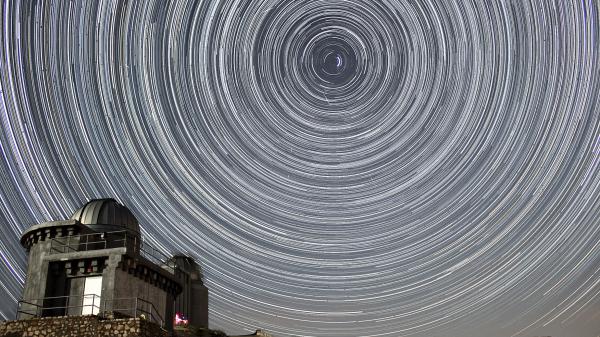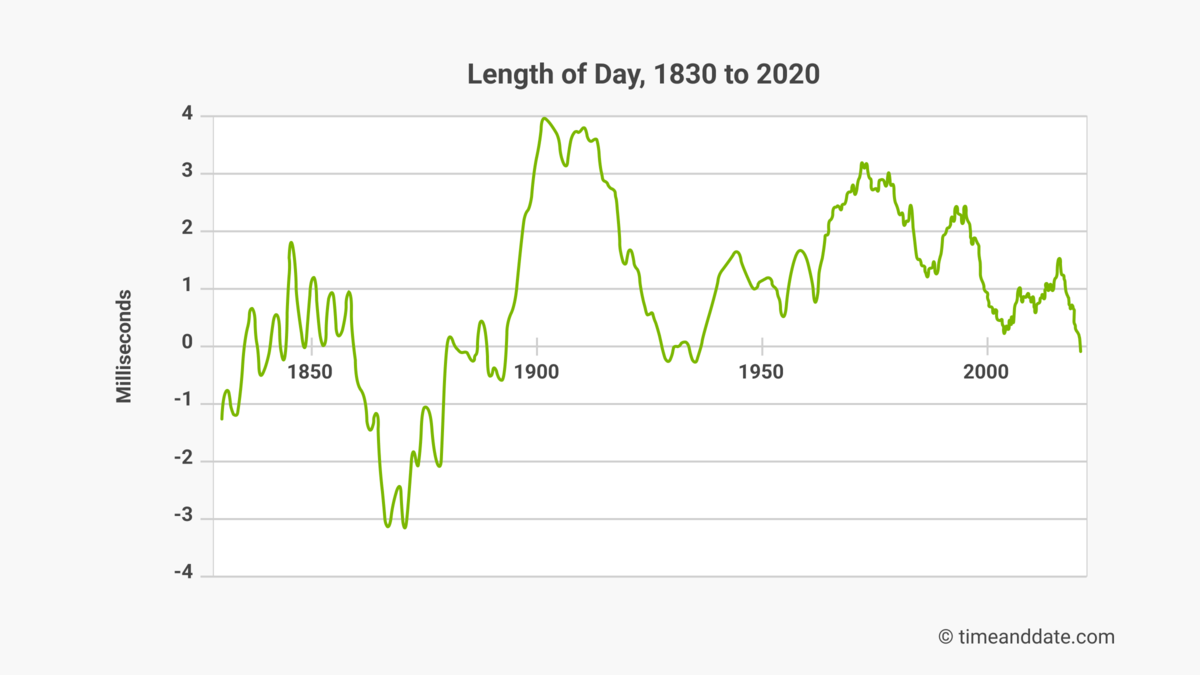24 Hours Is How Long
Exact 24-hour interval Length* — Jum, 21 Okt 2022
Today's prediction: 24 hours, 0 minutes, 0,0005984 seconds (0,5984 milliseconds)
Yesterday'south prediction: 24 hours, 0 minutes, 0,0003893 seconds (0,3893 milliseconds)
At the start of today, UT1 was 0.0051795 seconds backside UTC.
Look up a day length in the past
* Based on mean solar solar day. Numbers provided by the International Earth Rotation and Reference System Service (IERS).

The World's rotation slows downwards over time.
©iStockphoto.com/nukleerkedi
Globe'southward Rotation Defines Length of Day
Mod timekeeping defines a twenty-four hours as the sum of 24 hours—but that is not entirely correct. The World'southward rotation is non constant, so in terms of solar time, most days are a little longer or shorter than that.
The Moon is—very gradually—slowing the Globe's rotation considering of friction produced past tides. Over the course of a century, the length of a twenty-four hours increases past a couple of milliseconds (where 1 millisecond equals 0.001 seconds).
Inside this full general tendency, however, at that place is fluctuation: sometimes the Earth spins a bit faster, sometimes a bit slower. Recently, our planet has been speeding up a little, making for slightly shorter days.
How Long Is Today?
Today is predicted to be 0,5984 ms (milliseconds) or 0,0005984 seconds longer than 24 hours. This is the time it takes Globe to rotate 27,83 cm (10,96 in), equally measured at the equator.
This means that today lasts:
- 24,0000001662 hours or
- 24 hours and 0,sixty ms
On average, a mean solar solar day in the terminal 365 days was -0,27 ms under 24 hours, so today's day length is above average. Over this period, 9 days accept been longer than today, while 357 take been shorter than today.
If every 24-hour interval were as long as today, a leap second would have to exist added every 1671,12 days.
| Today'south Day Length* in Context | ||
|---|---|---|
| Day length | Appointment | |
| Yesterday | 24 hours +0,39 ms | Kam, 20 Okt 2022 |
| Today | 24 hours +0,60 ms | Jum, 21 Okt 2022 |
| Tomorrow | 24 hours +0,81 ms | Sab, 22 Okt 2022 |
| Shortest 2022 | 24 hours -one,59 ms | Rab, 29 Jun 2022 |
| Longest 2022 | 24 hours +0,99 ms | Sen, 24 Okt 2022 |
| Final Year Average | 24 hours -0,xviii ms | Year 2021 |
| * Yesterday's, today's, and future mean solar day lengths are predictions. | ||
Average Day Lengths & Leap Seconds
Overall, the Globe is a skillful timekeeper: the length of a day is consistently within a few milliseconds of 86,400 seconds, which is equivalent to 24 hours. Withal, over the course of months and years, these small differences can add together up and put our clocks out of sync with the Earth's spin. When this happens, a leap 2nd is used to bring them back into alignment.
Leap seconds can be positive or negative. A positive leap second adds a second to our clocks, while a negative leap 2nd subtracts a second.
The organisation of leap seconds was introduced in 1972. So far, in that location accept been 27 leap seconds, and they have all been positive. The tabular array beneath shows the yearly average day lengths since 1973.
| Average Twenty-four hour period Length* | |||||
|---|---|---|---|---|---|
| Year | Average mean solar day | Full yearly difference | Shortest solar day | Longest 24-hour interval | Bound second added |
| 2022 | -0,26 ms | -95,52 ms | 29 Jun -one,59 ms | 24 Okt +0,99 ms | - |
| 2021 | -0,eighteen ms | -65,15 ms | ix Jul -one,46 ms | 26 Apr +1,00 ms | - |
| 2020 | -0,00 ms | -one,xxx ms | 19 Jul -1,47 ms | 8 Apr +1,62 ms | - |
| 2019 | +0,39 ms | +141,25 ms | 16 Jul -0,95 ms | 22 Mar +1,68 ms | - |
| 2018 | +0,69 ms | +252,47 ms | 30 Jun -0,64 ms | 4 February +one,69 ms | - |
| 2017 | +ane,03 ms | +375,01 ms | 4 Agu +0,06 ms | 25 Apr +2,20 ms | - |
| * Current yr'due south average day length and total yearly difference are predicted. | |||||
Subscribe to our newsletter for leap 2nd alerts
How Is True Day Length Measured?
Astronomers and timekeepers express mean solar fourth dimension every bit Universal Time (UT1), a time standard based on the boilerplate speed of the Earth'due south rotation. UT1 is then compared to International Atomic Time (TAI), a super-precise time scale calculated past a network of diminutive clocks.
The actual length of a day is expressed as the departure of UT1 from TAI over 24 hours.
Why Isn't Earth's Rotation Abiding?
The speed of the Globe'south rotation varies from day to day. One of the master factors are the celestial bodies surrounding usa.
For example, the Moon'southward gravitational pull causes tides and changes the World's shape, ultimately resulting in a lower rotational speed. The distance betwixt Earth and Moon changes constantly, which makes for daily variations in the speed our planet rotates around its centrality.
Find Day Length for Any Date
How Far Back Does the Data Go?
Super-accurate diminutive clocks were first adult in the 1950s and 1960s. So measurements of the Earth's rotation using atomic clocks only go back as far as then.
Notwithstanding, telescopic timings of stellar occultations by the Moon provide data about the Globe's rotation going back to the 17th century. An occultation is when the Moon, every bit seen from the Earth, passes in front of a star.


This nautical chart, produced using data from the IERS, shows the length of twenty-four hour period going back to 1830. It indicates that Earth was spinning specially fast around the year 1870, and particularly slow around the start of the 1900s.
©timeanddate.com
Ancient Records Give Away Earth'south Speed
Going back even further, records of solar and lunar eclipses provide information from the eighth century BCE onwards.
For example, a Babylonian clay tablet tells us that a total solar eclipse was observable in the ancient city of Babylon on April 15, 136 BCE.
Mod computer models tin can summate the path of totality for this eclipse with a high degree of accuracy. From this, nosotros tin can piece of work out the Earth'south spin. For instance, if the World had been spinning a scrap faster at that time, the path of totality would accept passed to the w of Babylon—non directly over the city.
Eclipse database for years 1900-2199
24 Hours Is How Long,
Source: https://www.timeanddate.com/time/earth-rotation.html
Posted by: youngtoomen.blogspot.com


0 Response to "24 Hours Is How Long"
Post a Comment